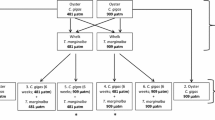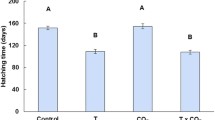Abstract
A process of serial resolution, each new “resolution” building upon insights drawn from earlier ones, of a set of more or less long-standing intellectual puzzles in fish behavioral biology and fisheries-environmental science is described and interpreted. Information on (1) the highly evolved capture-evasion capabilities of small prey fishes and on (2) size-related disadvantages with respect to oxygen replenishment constraints confronted by larger water-breathing nektonic predators is incorporated within a sequential narrative analysis of seven proffered “Enigmas.” A timescale-dependent tension between predator and prey emerges such that a fleeing smaller prey fish that manages to elude capture long enough to impose sufficient oxygen depletion penalties on its larger, faster swimming pursuer to induce cessation of the assault may ultimately escape to survive the incident; this particular insight may offer essential conceptual footing for underway studies of the vital importance of ambush predation in many ocean ecosystems. Various features of this posited set of “Enigmas” are found easiest to explain by postulating a compelling, perhaps even painful, avoidance signal that may be triggered when a fish’s central nervous system senses a developing internal oxygen storage deficit. Findings suggest that continuing ocean deoxygenation may act over time to decrease the success rate of larger water-breathing predators in capturing and consuming smaller prey. A causal linkage of ocean deoxygenation to historical overfishing is speculatively identified.
Similar content being viewed by others
Data availability
No actual data were assembled or analyzed in the course of this study, which used only widely accessible published information, the sources of which are cited in the text and identified in the reference list.
References
Arístegui J, Alvarez-Salgado XA, Barton ED, Figueiras FG, Hernandez-Leon S, Roy C, Santos AMP (2005) Chapter 23 - Oceanography and fisheries of the Canary Current/Iberian region of the eastern North Atlantic. In: Robinson AR, Brink K (eds) The sea, vol 14B. Harvard University Press, Cambridge, pp 879–933
Bakun A (1996) Patterns in the ocean: ocean processes and marine population dynamics. University of California Sea Grant, San Diego, California, USA, in cooperation with Centro de Investigaciones Biológicas de Noroeste, La Paz, Baja California Sur, Mexico 323 pp Newer printing, marketed by Amazon.com
Bakun A (2005) Regime shifts. In: Robinson AR, Brink K (eds) The sea, vol. 13. Harvard University Press, Cambridge, pp 971–1026
Bakun A (2006) Wasp-waist populations and marine ecosystem dynamics: navigating the “predator pit” topographies. Prog Oceanogr 68:271–288
Bakun A (2011) The oxygen constraint. In: Christensen V, Maclean J (eds) Ecosystem approaches to fisheries: a global perspective. Cambridge University Press, Cambridge, pp 11–23
Bakun A (2012) Patterns in the ocean: ocean processes and marine population dynamics. CreateSpace Independent Publishing Platform, 346 pp
Bakun A (2014) Active opportunistic species as potential diagnostic markers for comparative tracking of complex marine ecosystem responses to global trends. ICES J Mar Sci 71:2281–2292
Bakun A (2017) Climate change and ocean deoxygenation within intensified surface-driven upwelling circulations. Philos T Roy Soc, A 375(2102):20160327
Bakun A (2022) Vertical Ambush Corridors: intriguing multi-mechanism ecological structures embedded in the kinetic fluid architectures of oceanliving resource production systems. Fish Fish (in press)
Bakun A, Weeks SJ (2006) Adverse feedback sequences in exploited marine ecosystems: are deliberate interruptive actions warranted? Fish Fish 7:316–333
Bleakley A (2005) Stories as data, data as stories: making sense of narrative inquiry in clinical education. Med Educ 39:534–540. https://doi.org/10.1111/j.1365-2929.2005.02126.x
Breitbart D, Levin LA, Oshlies A, Grégoire M, Chavez FP, Conley DJ, Garçon, Gilbert D, Gutiérrez D, Jacinto GS, Limburg KE, Montes I, Naqvi SWA, Pitcher GC, Rabalais NN, Roman MR, Rose KA, Seibel BA, Telszewski M, Yusuhara m, Zhang J (2018) Declining oxygen in the global ocean and coastal waters. Science 359 (6371). https://doi.org/10.1126/science.aam7240
Brotz, L (2011) Changing jellyfish populations: trends in large marine ecosystems. Master of Science Thesis. University of British Columbia. Vancouver, Canada: 198 pp
Budelmann BU (1996) Active marine predators: the sensory world of cephalopods. Mar Freshw Behav Phys 27(2–3):59–75
Carmen T (2018) Scientists say fish feel pain. It could lead to major changes in the fishing industry. Washington Post, May 24, 2018. https://www.washingtonpost.com/news/food/wp/2018/05/24/scientists-say-fish-feel-pain-it-could-lead-to-major-changes-in-the-fishing-industry/
Caverivière A (1991) L'explosion démographique du baliste (Balistes carolinensis) en Afrique de l'Ouest et son évolution en relation avec les tendances climatique. In: Cury P, Roy C (eds) Pêcheries Ouest-Africaines Variabilité, Instabilité et Changement (p 354–367) ORSTOM Editions, Paris, 524 pp
Chalmers M (2021) Do fish feel pain? The science behind fish sentience. Sentient Media, San Francisco, CA USA. https://sentientmedia.org/do-fish-feel-pain/
Denny M (1993) Air and water. Princeton University Press, Princeton, p 360
Diaz RJ, Rosenberg R (2008) Spreading dead zones and consequences for marine ecosystems. Science 321:926–929
Domenici P, Wilson ADM, Kurvers RHJM, Marras S, Herbert-Read JE, Steffensen JF, Krause S, Viblanc PE, Couillaud P, Krause J (2014) How sailfish use their bills to capture schooling prey. Proc R Soc B 281:20140444
Earle SA, Wright DJ, Joye S, Laffoley D, Baxter J, Safina C, Elkus P (2018) Ocean deoxygenation: time for action. Science 359(6383):1475–1476
Gilly WF, Markaida U, Baxter CH, Block BA, Boustany A, Zeidberg L, Reisenbichler K, Robison B, Bazzino G, Salinas C (2006) Vertical and horizontal migrations by the jumbo squid Dosidicus gigas revealed by electronic tagging. Mar Ecol Prog Ser 324:1–17
Halper P, Williford K, Rudrauf D, Fuchs PN (2021) Against Neo-Cartesianism: Neurofunctional Resilience and Animal Pain. Philos Psychol 34(4):474–501
Harmon K (2010) Humboldt squid seem to be thriving-thanks to Ocean Dead Zones. Sci Am. https://www.scientificamerican.com/article/humboldt-squid-expansion/
Helly J, Levin L (2004) Global distribution of naturally occurring marine hypoxia on continental margins. Deep-Sea Res I 51:1159–1168
Houde ED (2008) Emerging from Hjort's shadow. J Northwest Atl Fish Sci 41: 53–70
Hsieh C, Glaser SM, Lucas AJ, Sugihara G (2005) Distinguishing random environmental fluctuations from ecological catastrophes for the North Pacific Ocean. Nature 435:336–340
IOC-UNESCO (2018) The ocean is losing its breath: declining oxygen in the world’s ocean and coastal waters; summary for policy makers. IOC Tech Ser IOC/2018/TS/137 REV. 39 pp
Jabr F (2018) Fish feel pain. Now what? Hakai Magazine00–1002 Wharf St.,Victoria, BC V8W 1T4 Canada Article also accessible at: Smithsonian Magazine, January 8, 2018 edition. https://www.smithsonianmag.com/sciencenature/fish-feel-pain-180967764/
Kang B, Bakun A, Lin L, Pauly D (2021) Increase of a hypoxia-tolerant fish, Harpadon nehereus (Synodontidae), as a result of ocean deoxygenation off southwestern China. Environ Biol Fish. https://doi.org/10.1007/s10641-021-01130-7
Kawasaki T (1983) Why do some fishes have wide fluctuations in their numbers? - Biological basis of fluctuation from the viewpoint of evolutionary ecology. In Proceedings of the Expert Consultation to Examine Changes in Abundance and Species Composition of Neritic Fish Resources, San Jose, Costa Rica, April 1983. Sharp, G. D. & J. Csirke (Eds). FAO Fish Rep 291(3): 1065–1080.
Keeling RF, Körtzinger A, Gruber N (2010) Ocean deoxygenation in a warming world. An Rev Mar S 2:199–229
Laffoley D, Baxter JM (eds) (2019) Ocean deoxygenation: everyone’s problem. IUCN, Global Marine and Polar Programme. IUCN, Gland
Levin SA (1998) Ecosystems and the biosphere as complex adaptive systems. Ecosystems 1:431–436
Mirza M (2020) India’s brilliant Bombay duck. BBC, Travel: https://www.bbc.com/travel/article/20200120-indiasbrilliant-bombay-duck
Pauly D (1979) Gill size and temperature as governing factors in fish growth: a generalization of von Bertalanffy’s growth formula. Ber Inst Meeresk 63: 156
Pauly D (1981) The relationships between gill surface area and growth performance in fish: a generalization of von Bertalanffy’s theory of growth. Meeresforschung 28:251–282
Pauly D (1984) A mechanism for the juvenile-to-adult transition in fishes. J Cons Int Explor Mer 41:280–284
Pauly D (2019) Gasping fish and panting squids: oxygen, temperature and the growth of water-breathing animals–2nd edition. Excellence in Ecology (22), International Ecology Institute, Oldendorf/Luhe, 279 p
Pauly D (2021) The gill-oxygen limitation theory (GOLT) and its critics. Science Advances 7, eabc6050 (6 January 2021)
Pauly D, Christensen V, Dalsgaard J, Torres FJR, FC, (1998) Fishing down marine food webs. Science 279:860–863
Popper AN, Hawkins AD (2019) An overview of fish bioacoustics and the impacts of anthropogenic sounds on fishes. J Fish Biol 94:692–713
Pulikotti JJ (2012) http://www.slideshare.net/DevikaAntharjanam/bombay-duck2
Richardson AJ, Bakun A, Hays GC, Gibbons MJ (2009) The jellyfish joyride: causes, consequences and management responses to a more gelatinous future. Trends Ecol Evol 24(6):312–322
Rose JD, Arlinghaus R, Cook SJ, Diggles BK, Sawynok W, Stevens ED, Wynne CDL (2014) Can fish really feel pain? Fish Fish 15(1):97–113
Schwartzlose RA, Alheit J, Bakun A, Baumgartner T, Cloete R, Crawford RJM, Fletcher WJ, Green-Ruiz Y, Hagen E, Kawasaki T, Lluch-Belda D, Lluch-Cota SE, MacCall AD, Matsuura Y, Nevares-Martinez MO, Parrish RH, Roy C, Serra R, Shust KV, Ward NM, Zuzunaga JZ (1999) Worldwide large-scale fluctuations of sardine and anchovy populations. S Afr J Marine Sci 21:289–347
Walters CJ, Juanes F (1993) Recruitment limitation as a consequence of natural selection for use of restricted feeding habitats and predation risktaking by juvenile fishes. Can Fish Aquat Sci 50:2058–2070
Walters CJ, Martell SJD (2004) Fisheries ecology and management. Princeton University Press, Princeton
Zeidberg LD, Robison BH (2007) Invasive range expansion by the Humboldt squid, Dosidicus gigas, in the eastern North Pacific. PNAS 104 (31). www.pnas.org.cgi. https://doi.org/10.1073/pnas.0702043104
Acknowledgements
Daniel Pauly provided an extremely useful pre-submission critique.
Author information
Authors and Affiliations
Corresponding author
Ethics declarations
Ethics approval
No human or animal test subjects were involved.
Conflict of interest
The author declares no competing interests.
Additional information
Publisher's note
Springer Nature remains neutral with regard to jurisdictional claims in published maps and institutional affiliations.
Rights and permissions
Springer Nature or its licensor holds exclusive rights to this article under a publishing agreement with the author(s) or other rightsholder(s); author self-archiving of the accepted manuscript version of this article is solely governed by the terms of such publishing agreement and applicable law.
About this article
Cite this article
Bakun, A. Adjusting intuitions as to the role of oxygen constraints in shaping the ecology and dynamics of ocean predator–prey systems. Environ Biol Fish 105, 1287–1299 (2022). https://doi.org/10.1007/s10641-022-01317-6
Received:
Accepted:
Published:
Issue Date:
DOI: https://doi.org/10.1007/s10641-022-01317-6




